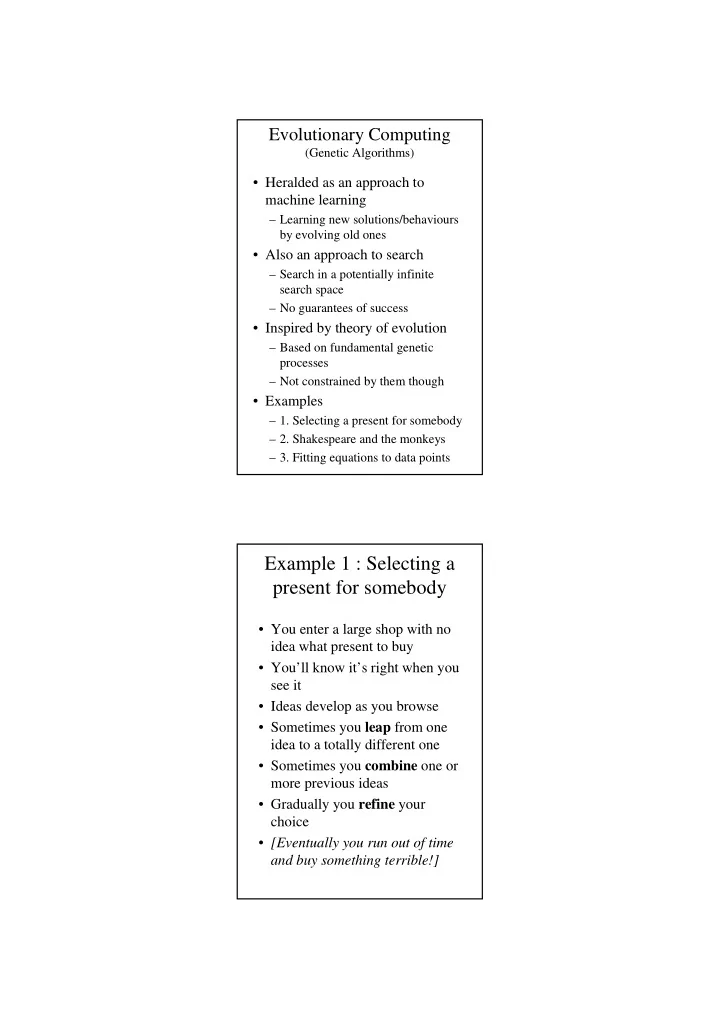

Evolutionary Computing (Genetic Algorithms) • Heralded as an approach to machine learning – Learning new solutions/behaviours by evolving old ones • Also an approach to search – Search in a potentially infinite search space – No guarantees of success • Inspired by theory of evolution – Based on fundamental genetic processes – Not constrained by them though • Examples – 1. Selecting a present for somebody – 2. Shakespeare and the monkeys – 3. Fitting equations to data points Example 1 : Selecting a present for somebody • You enter a large shop with no idea what present to buy • You’ll know it’s right when you see it • Ideas develop as you browse • Sometimes you leap from one idea to a totally different one • Sometimes you combine one or more previous ideas • Gradually you refine your choice • [Eventually you run out of time and buy something terrible!]
Example 2 : Shakespeare and the monkeys • Dawkins (1986) considered a single line from Hamlet: METHINKS IT IS LIKE A WEASEL • The probability of generating this line of 28 characters (including the spaces) from the 27 character alphabet by chance is (1/27)^28 • Or, put another way, after 27^28 attempts you could expect to produce it just once (after millions of years) • Dawkins wrote a GA program which generated the line in between 41 and 64 attempts (taking about 11 seconds) • Instead of single-step selection the program used cumulative selection Example 3 : Fitting equations to data points • Consider the equation for a straight line between 2 points: y = mx + c • Given the points ( x1,y1 ) and ( x2,y2 ) we can determine m and c • Using a GA we could start off with random values for m and c and gradually evolve better and better values for m and c by making small changes and breeding from the best until the error is acceptably small • This is a trivial problem but with larger data sets (more than just 2 points) the GA approach offers a potential route to a solution
Three Main Forms Three main forms of EC are distinguished– • Genetic Algorithm (GA) – The classical form – Evolving new states from old during search • Genetic Programming (GP) – Evolving computer programs – Using GAs to evolve source code or representations thereof • Evolutionary Strategies (ES) – Probabilistic – Mutation-based search – cf. stochastic random walk Key Elements of a GA • Natural Selection – A fitness measure determines which population members (solutions) survive • Reproduction – Creating a successor generation by ... • Crossover of chromosomes – Combining two or more “parents” to form “offspring” • Mutation of genes – Introducing aberrant offspring at random intervals • Probability – All choices are probabilistic
The GA Method • A population pool is created – This contains possible solutions • A fitness function is applied to each individual – This determines how “good” each solution is • Individuals are selected for a mating pool probabilistically – The fitter the individual the more likely it is to be selected • Individuals in the mating pool are combined using crossover – Again selection is probabilistic – Crossover points are also selected probabilistically (mutation may occur) • The fittest individuals become the next generation Fitness Functions • A quality function rates each individual’s “goodness” • Fitness is commonly normalised to lie between 0 and 1 – The fitness of an individual is then the quality of that individual divided by the total quality of all individuals in the population • Identifying fitness functions is one of the more difficult tasks in evolutionary computing
Selection Schemes • Rank – The fittest individuals in the current generation are chosen for the mating pool • Roulette – Fitter individuals are allocated a larger area of the wheel – Thus they are more likely to be chosen than less fit individuals • Tournament – Pairs of individuals compete for entry to the mating pool by comparing their fitness scores – Successive rounds of pairing off can further reduce the number of candidates for the mating pool • Elitist – The fittest individual(s) always proceed to the next generation – By-passing the mating pool Reproduction • Reproduction creates candidates for the next generation of individuals by recombining elements from the current generation which have been selected for the mating pool • Genetic recombination produces offspring – Part of the genome of each parent is passed on to the offspring – In humans one half of each chromosome pair is passed on by each parent • Mutation of genes can occur during recombination – This is very rare – You can envisage mutation as changes within the substrings
Crossover Individual A a1 a2 a3 a4 a5 a6 Individual B b1 b2 b3 b4 b5 b6 Pick a crossover point, say 4 O ffspring 1 a1 a2 a3 a4 b5 b6 O ffspring 2 b1 b2 b3 b4 a5 a6 Mutation a1 a2 a3 a4 b5 b6 Select gene to mutate, say 3 and value to mutate it to, say c3 a1 a2 c3 a4 b5 b6 EC Bibliography • Dawkins, R., 1986, The Blind Watchmaker , Penguin Books. • Fogel, L., Evans, M. & Walsh , M., 1966, Artificial Intelligence through Simulated Evolution , John Wiley. • Goldberg, D.E. & Holland, J.H., (editors), 1988, special issue of Machine Learning , 3 (2/3). • Goldberg, D.E., 1989, Genetic Algorithms in Search, Optimisation and Machine Learning , Addison-Wesley. • Holland, J.H., 1992, Adaptation in Natural and Artificial Systems , 2nd edition, MIT Press. • Koza, J.R., 1992, Genetic Programming , MIT Press. • Rechenberg, I., 1971, Evolutionsstrategie - Optimierung nach Prinzipien der biologischen Evolution, Dr.-Ing. Thesis, Technical University of Berlin.
Recommend
More recommend